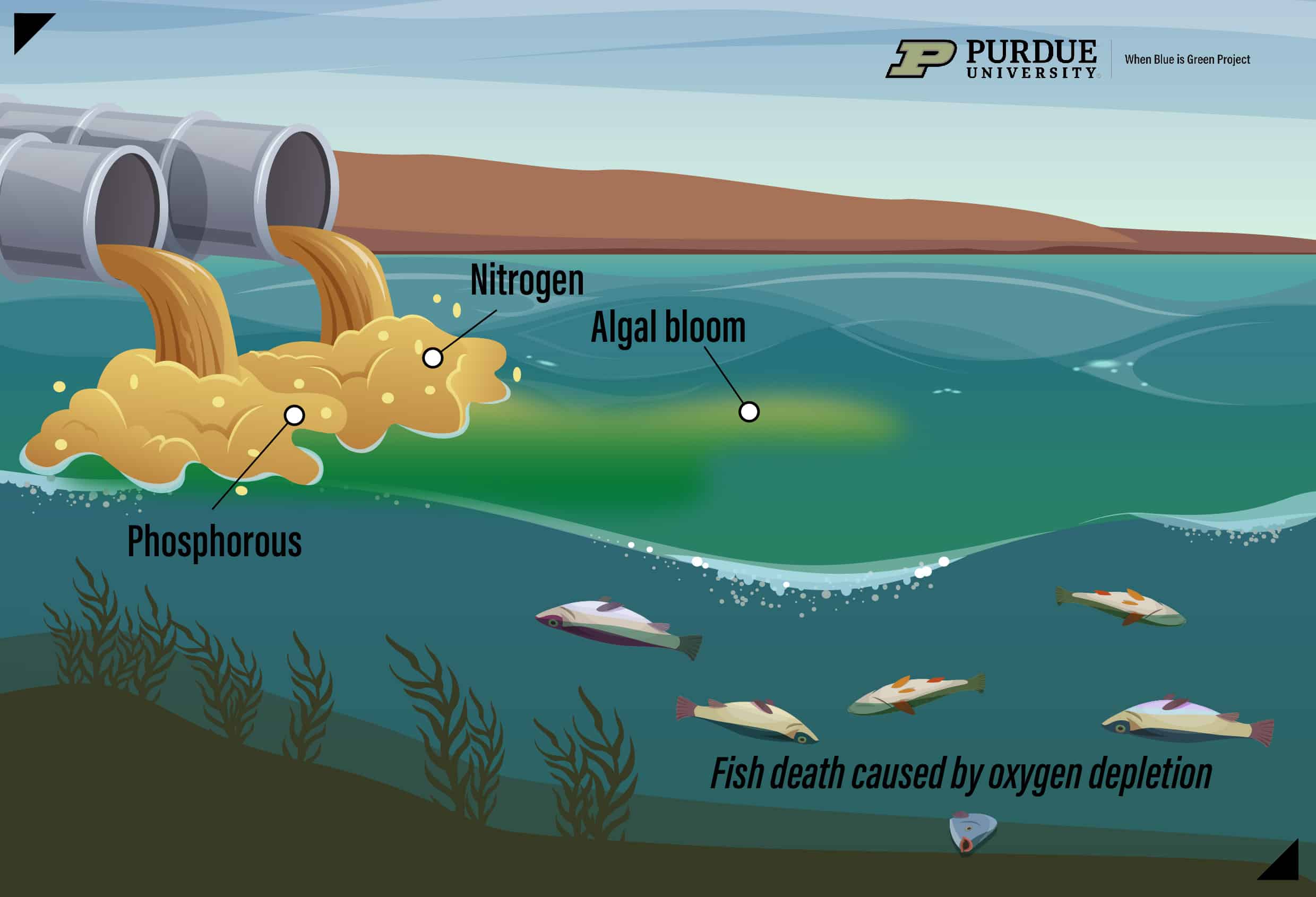Summary
- Ultrasound technology is revolutionary in controlling algae blooms and maintaining water quality without chemicals.
- Smart technologies, including advanced sensors and cloud-connected platforms, are essential for real-time monitoring of water quality, enabling proactive lake management.
- Climate change significantly impacts freshwater lakes, causing declining oxygen levels and promoting harmful algal blooms, necessitating urgent action and innovative solutions.
How Does Climate Change Affect Freshwater Lakes?
Climate change negatively impacts freshwater lakes. Caused by rising water temperatures, reduced oxygen levels, increased stratification, and the proliferation of harmful algal blooms. These changes impacting the overall earth’s atmosphere threaten the health and biodiversity of the planet. Eutrophication is the process where nutrient pollution causes algal blooms, significantly degrading water quality. To control algae blooms it’s essential to have effective methods are both long-term and environmentally friendly. Solutions include implementing advanced fertilizer technologies, fostering collaboration among stakeholders, and utilizing sonication technology to mitigate its effects.
Studies on Climate Change
According to a 2021 study published in Nature titled “Widespread deoxygenation of temperate lakes” by Stephen F. Jane and others, the impacts of climate change on freshwater lakes are profound and far-reaching. Based on the data presented in this research, oxygen levels in temperate freshwater lakes have declined significantly since 1980, by approximately 5.5% at the surface and 18.6% in deeper waters. Alarmingly, this deoxygenation is occurring 2.75 to 9.3 times faster than in the world’s oceans, underscoring the heightened vulnerability of freshwater ecosystems to climate change. Rising water temperatures reduce oxygen saturation in surface waters. This phenomenon is exacerbated by increasing stratification, which hampers the replenishment of oxygen in deep waters. Consequently, the loss of oxygen in lakes promotes the growth of bacteria that emit methane, a potent greenhouse gas, further contributing to climate change.
Declining oxygen levels cause sediments to release more phosphorus, worsening water quality and promoting algal blooms. Over 83% of the world’s freshwater lakes are experiencing oxygen decline due to heat waves and climate change. This alarming trend threatens the delicate balance of these ecosystems, leading to biodiversity loss and compromised water quality. Algal blooms are a visible and harmful consequence of climate change on these lakes. These blooms not only disrupt the ecological balance but also pose significant health risks to humans and animals. The increase in toxic cyanobacteria can lead to the closure of recreational lakes and higher treatment costs for drinking water reservoirs.
Addressing climate change impacts on freshwater lakes requires urgent climate action and a comprehensive understanding of environmental issues. Implementing smart lake management practices and investing in sustainable development helps improve these environmental impacts and protect vital water resources.
Benefits of Integrating Nature-Inspired Solutions
Integrating nature-based solutions with smart technology is a powerful way to support healthy ecosystems. It’s also the most effective method to control algal blooms without chemicals. Environmental sustainability is vital for human survival, and by learning from nature, we can develop more sustainable and effective lake management practices. The principles of environmental science and sustainability emphasize the importance of understanding and mimicking natural processes, which must be understood. By doing so, we can create solutions that work in harmony with the environment, rather than against it. This approach not only benefits the ecosystem but also supports the well-being of local communities, human society, and culture as a whole, highlighting various aspects of our interconnected world and promoting environmental stability.
The Royal Society and other scientific organizations advocate for the integration of nature-inspired solutions in various fields, including lake management. These solutions contribute to achieving sustainable development goals and addressing environmental issues related to climate change, pollution, biodiversity loss, and living organisms. Scientists emphasize the importance of these approaches in promoting a healthier ecosystem. Combining the best practices from nature with advanced technologies focuses on developing innovative and sustainable solutions. This approach ensures that we meet the present needs without compromising the ability of future generations to meet their own needs, which have been developed through careful form consideration.
The Role of Soundwaves in Lake Management
Sound waves, particularly ultrasound technology, are revolutionizing the way we manage our lakes. This sustainable development is effectively controlling harmful algal blooms and maintaining water quality, offering a chemical-free solution to a persistent problem. Ultrasound targets the gas vesicles in cyanobacteria, distrupts the algaes buoyancy and selectively destroys these harmful microorganisms without affecting other aquatic life. The development of novel technologies, including advanced remote sensing and machine learning algorithms, is significantly boosting lake management practices. These advancements enable more precise monitoring and targeted interventions, ensuring that our lakes remain healthy and resilient. With sound waves at the forefront, we can address environmental challenges more efficiently and sustainably.
Lakes are dynamic ecosystems that play a crucial role in our environment. They regulate climate, provide drinking water, and offer recreational opportunities, making their health vital to both the ecosystem and human society. Harnessing the power of sound waves helps ensure these natural resources and earth’s ecosystems continue to thrive. Integrating sound wave technology into lake management addresses immediate environmental issues and paves the way for more advanced and sustainable future practices.
Smart Technologies for Water Quality Monitoring
Smart technologies are indispensable in lake management. Modern environmental monitoring buoys, equipped with sensors, collect crucial data remotely, aiding in effective management. These systems track environmental parameters like water temperature, turbidity, and dissolved oxygen levels, offering a comprehensive picture of water health. Optical sensors, analog sensors, and chemical sensors detect minute changes in water’s chemical composition and physical properties, ensuring deviations are promptly detected and addressed. The precision of these sensors is critical, as it enhances the monitoring of water quality in lakes, helping to measure potential issues before they escalate. Detection is essential for maintaining water quality.
Cloud-connected data dashboards further enhance the capabilities of these monitoring systems. These dashboards provide real-time environmental data, facilitating timely decision-making and enabling proactive lake management. Integrating technology ensures swift responses to changes in water quality, maintaining the delicate balance of freshwater ecosystems. The fusion of multi-sensor data approaches addresses the weaknesses of individual sensors, leading to more comprehensive lake monitoring. Integrating data from multiple sources provides a more accurate and holistic understanding of lake health, ensuring compliance with environmental regulations and promoting long-term sustainability.
How to Combat Eutrophication?
Eutrophication, driven by nutrient runoff from agriculture and urban areas, leads to algal blooms. This inturn, chokes biodiversity and compromises water quality. Innovative solutions are essential to address this pressing environmental issue and ensure the sustainability of our freshwater lakes.

An example of such innovation is the installation of advanced fertilizer technologies. Such technologies help minimize nutrient runoff and reduce the risk of eutrophication in waterways. These technologies are capable of removing phosphorus and nitrogen from the water. Hence, preventing their buildup in surface waters and reducing the risk of harmful algal blooms. Collaborative efforts between agricultural firms and research institutions are vital for developing targeted solutions that address the root causes of nutrient pollution. Furthermore, promoting sustainable agricultural practices.
Collaborative efforts between agricultural firms and future research are vital for developing targeted solutions that address the root causes of nutrient pollution. These solutions can hence, promote sustainable agricultural practices. Moreover, incase there is a toxic outbreak, then rest assured ultrasound technology can control algae blooms. One such case study is the installation of the Laguna de Bay. Philippines’ largest freshwater lake and the third-largest in Southeast Asia. This smart technology integrates real-time water quality monitoring with ultrasound technology to effectively reduce and control harmful algae blooms.
What Types of Sensors Are Used in Water Quality Monitoring?
The system’s optical, analog, and chemical sensors continuously measure parameters such as chlorophyll-a, phycocyanin, and dissolved oxygen levels. By analyzing this data, the MPC-Buoy provides targeted ultrasonic treatment to disrupt the gas vesicles of cyanobacteria. This prevents their proliferation without harming other aquatic life. The above mentioned case study highlights the effectiveness of combining advanced sensor technology with sound waves to achieve sustainable lake management and address pressing environmental issues. Detecting algal blooms early and adjusting aeration systems to optimize oxygen levels allows operators to proactively manage water quality and prevent eutrophication for achieving clean waters.
Another study showed that sonication devices can selectively target cyanobacteria by inducing cavitation in their gas vesicles without harming other microorganisms. These examples highlight the deep importance of ongoing research and innovation in the flow of lake management, providing a good example of how continuously refining and validating these technologies ensures their effectiveness and contributes to the long-term health of freshwater ecosystems.
Broader Goals Supported by Smart Lake Management
Smart lake management aligns with ESG principles and promotes responsible environmental practices. Involving local communities in lake management fosters public awareness and advocacy for sustainable practices, contributing to more effective and long-term solutions.
Effective lake management practices contribute to achieving the United Nations Sustainable Development Goals by enhancing aquatic ecosystems and promoting environmental sustainability. These practices help improve local economies by supporting tourism and recreational activities, providing economic benefits that extend beyond the immediate environmental impact.
Nature-inspired solutions and smart technologies also create job opportunities across various industries, supporting economic growth and sustainable development. The careful planning and implementation of these device technologies ensure that we understand the extent of their energy output and maximize their benefits.
Integrating advanced technologies and sustainable practices supports broader goals like ESG compliance, community engagement, and long-term sustainability planning. This holistic approach ensures that our efforts to manage and protect our lakes are both effective and sustainable.
Summary
The future of lake management lies in the invisible power of soundwaves and the integration of smart technologies to control algae blooms. By leveraging ultrasound technology, we can control harmful algal blooms and maintain water quality without relying on chemicals. Smart technologies, including advanced sensors and data analytics, provide real-time monitoring and enable proactive management of our freshwater ecosystems.
Climate change poses significant challenges to lake health, with rising temperatures and declining oxygen levels threatening the delicate balance of these ecosystems. Innovative solutions, such as advanced fertilizer technologies and collaborative efforts, are essential for addressing eutrophication and ensuring environmental sustainability.
Integrating nature-inspired solutions with smart technologies offers a promising approach to maintaining healthy ecosystems. By aligning with broader goals like ESG compliance and sustainable development, we can support long-term sustainability and protect our lakes for future generations.
